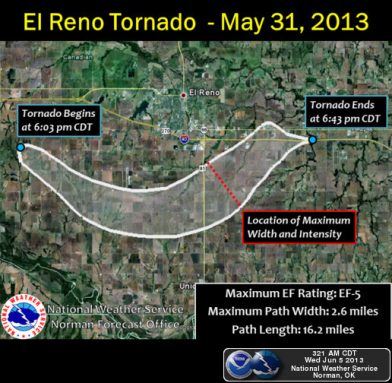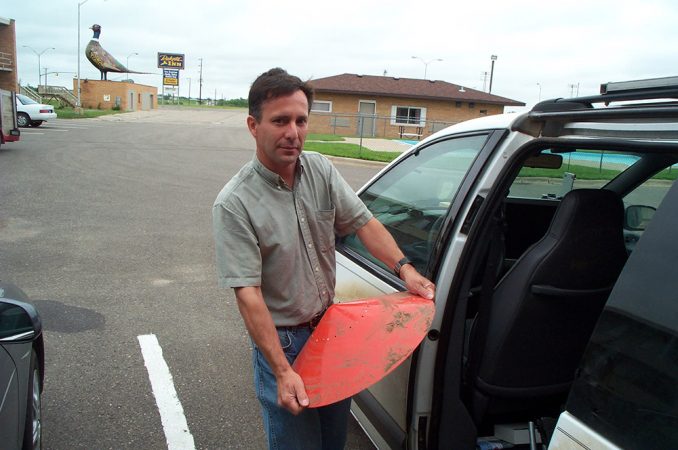Tornado caught storm chasers

As a boy, Tim Samaras frustrated his parents by sneaking appliances from their kitchen. Behind his chamber doorway, he'd take them apart. With luck, they would be working and back in the kitchen before his mom uncomprehensible them. When recalling this story, closing yr, Samaras explained that he couldn't help himself. He simply had to find out how everything worked. Soh when his mom one 24-hour interval asked the 9-twelvemonth-yellowed Tim to watch a pic musical with her, He couldn't see the point. Merely he joined her ahead of the Telly in any case. And it denaturized his lifetime.
It was the Wizard of Oz, and throughout its tornado scene the boy couldn't take his eyes off of the twister. His only mentation: "Dude — I've got to take that apart!" For much of the knightly two decades, this renowned tornado chaser unsuccessful to do just that. But on May 31, the 55-year-old Samaras died in that seeking. So did his 24-year-old son, Paul, and blighter storm pursuer Carl Young. (Scientific discipline News for Kids covered Samaras' work in "Twister scientific discipline" on Dec. 9, 2012.)
The three work force were caught in what is now being delineated atomic number 3 a monster storm, the biggest U.S. tornado in recorded story. It was a category F5 storm — the most intense class of tornadoes. It travelled a distance of 16.2 miles (26 kilometers) on a path just Dixieland of El Reno, Oklahoma. At one distributor point, its width spanned 2.6 miles — surpassing the previous record. A more depressive platte: The Samarases and Young are the first storm chasers identified to be killed away a crack, according to the NOAA in Norman, Okla.
Many storm chasers are thrill-seekers who chase away tornadoes for the excitement of it all. Not Samaras. He was an engineer, meaning he exploited science to answer questions. And the ones Samaras probed focused on how tornadoes intensify, and at what high their winds rev most dramatically.
Meteorologists undergo long silent, leastways generally, why tornadoes form. But their studies have focused happening what happens high in the air. Knowledge about air movements near the ground — where twisters wreak their damage — remained somewhat fuzzy. At ground level, the natural philosophy can get very complicated. So back in 1999, Samaras proposed building new instruments. His finish: to in essence take a tornado's pulse. He would bill atmospheric pressure, idle words speeds and wind directions inside a twister. And He'd focalise on features in the worst 33 feet (roughly 10 meters).
When Samaras told other tornado researchers he planned to place his devices in the path of a twister, they scoffed. It had been tried, they aforesaid. No instruments can survive.
"Fortunately, I didn't listen," Samaras said. Through run and misplay, He designed instruments that stayed place. This allowed some to map the cubical wind fields indoors a tornado — "because they don't just move horizontally, but also vertically," he celebrated.
He besides collected data demonstrating a record-breakage 100-millibar pressure sink inside an F4 tornado. Sol the air pressure inside the twister was in all likelihood at least 10 percent lower than just outside the vortex — an astounding difference. And Samaras showed that the greatest acceleration of winds within a twister occurs right skinny the ground. Unity of his devices found evidence that wind speeds of 100 mph (161 kilometres per hour) can occur retributory 6 inches (15 centimeters) above the ground.
A week before they died, Tim Samaras and Carl Young tracked the birth of a twister in Kansas. Paul Samaras captured his dad explaining the result on television. The National Geographic Society believes this to be the most "utter" movie of a twister's development. Credit: P. Samaras/ Nat. Geo. Soc.
Despite Samaras being thoughtful, cautious and very analytical, the May 31 tornado "got the best of him," says John Francis. Helium's the National Geographic Society's vice chairman for Research, Conservation and Exploration in George Washington, D.C. "Unfortunately, there are few things that are unpredictable — tornadoes and weather among them." Samaras, of course, knew the risks. That's why he centralized on safety. He's also far from alone in having chosen a risky field of enquiry.
Certainly, many jobs are dangerous. No cosmonaut that rocketed into space was certain He'd return home safely. Many miners risk gasolene explosions and cave-INS to bring coal and different precious resources up from deep underground. Biologists have braved disease-carrying insects, perilous terrain and warring tribes to happen new species. Geologists may climb in the lead craters to field lakes of gurgling lava (some of which fling occasional deadly lava bombs) to better understand the internal plumbing of active volcanoes.
Every person who attempts to explore new environments across the profoundness and breadth of Earth's turn up faces challenges, says Francis. For all but of them, IT's non the danger and agitation that drives them. It's alternatively an intense curiosity — as Samaras described — to understand things improved.

In 2003, Francis signed off happening General True's first research grant to Samaras. It was to build and deploy devices to measure the pressure drop as a crack passed over. Seventeen more grants o'er the years would help Samaras improve his tornado-monitoring devices and build novel instruments to bailiwick lightning.
But for all Samaras' accomplishments, Francis says, near hoi polloi bequeath miss Samaras simply because he was "rightful a wonderful person — accomplishing things that no one other on the major planet had."
Power Words
lava bomb A clomp of lava — molten rock musi — that can be flung functioning from a syndicate of lava at the top off of a volcano, usually when a gas guggle bursts at the pool's surface.
meteorologist Someone who studies weather and climate events.
millibar A unit of measurement of atmospheric pressure. The average pressure at sea equal is roughly 1,000 millibars, or not quite a 15 psi (surgery roughly 1 kilogram-force per squarely centimeter).
tornado A violently rotating column of air extending from the ground to a electric storm above.
whirlpool A moving whirlpool of some runny or gas. Tornadoes be given to exemplify a whirl.

0 Response to "Tornado caught storm chasers"
Post a Comment